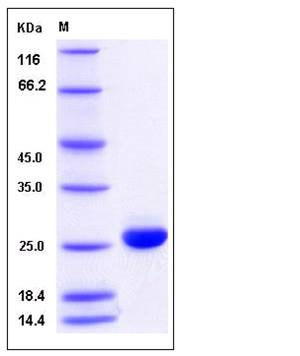Human BLVRB / biliverdin reductase B Protein (His Tag)
BVRB,FLR,HEL-S-10,SDR43U1
- 100ug (NPP3609) Please inquiry
| Catalog Number | P13151-H07E |
|---|---|
| Organism Species | Human |
| Host | E. coli |
| Synonyms | BVRB,FLR,HEL-S-10,SDR43U1 |
| Molecular Weight | The recombinant human BLVRB consisting of 216 amino acids and has a calculated molecular mass of 23.5 kDa. It migrates as a kDa band in SDS-PAGE under reducing conditions as predicted. |
| predicted N | Met |
| SDS-PAGE |  |
| Purity | > 97 % as determined by SDS-PAGE |
| Protein Construction | A DNA sequence encoding the human BLVRB (P30043) (Ala 2-Gln 206) was expressed, with a polyhistide tag at the N-terminus. |
| Bio-activity | |
| Research Area | Epigenetics |Apoptosis |Oxidative Stress |Additional Reduction/Oxidation (Redox) Enzymes |
| Formulation | Lyophilized from sterile PBS, 0.02% Brij35, 10% glycerol, pH 7.5 1. Normally 5 % - 8 % trehalose and mannitol are added as protectants before lyophilization. Specific concentrations are included in the hardcopy of COA. |
| Background | Biliverdin reductase (hBVR) is a serine/threonine kinase that catalyzes reduction of the heme oxygenase (HO) activity product, biliverdin, to bilirubin. BVR consists of an N-terminal dinucleotide-binding domain (Rossmann-fold) and a C-terminal domain that contains a six-stranded β-sheet that is flanked on one face by several α-helices. The C-terminal and N-terminal domains interact extensively, forming the active site cleft at their interface. Biliverdin reductase (BVR) catalyzes the last step in heme degradation by reducing the γ-methene bridge of the open tetrapyrrole, biliverdin IXα, to bilirubin with the concomitant oxidation of a β-nicotinamide adenine dinucleotide (NADH) or β-nicotinamide adenine dinucleotide phosphate (NADPH) cofactor. It is now recognized that human BVR (hBVR) is a dual-specificity kinase (Ser / Thr and Tyr) upstream activator of the insulin/insulin growth factor-1 (IGF-1) and mitogen-activated protein kinase (MAPK) signaling pathways. Human BVR (hBVR) is essential for MAPK-extracellular signal-regulated kinase (ERK)1/2 (MEK)-eukaryotic-like protein kinase (Elk) signaling and has been identified as the cytoplasm-nuclear heme transporter of ERK1/2 and hematin, the key components of stress-responsive gene expression. |
| Reference |
